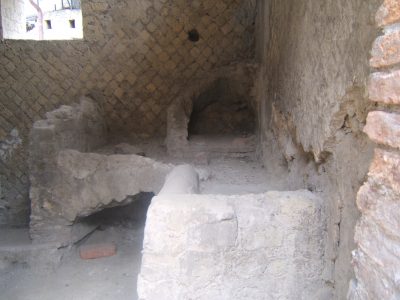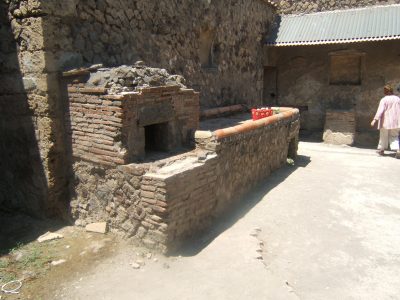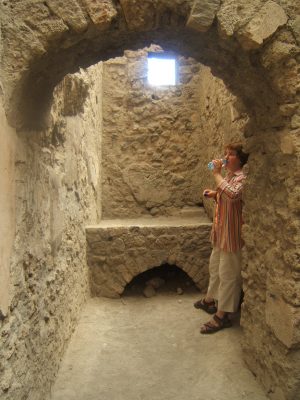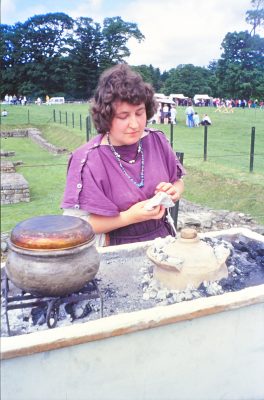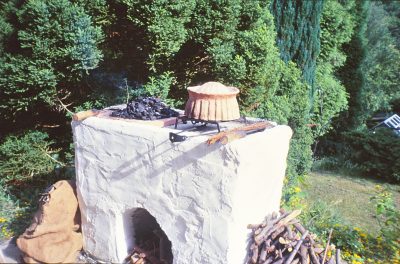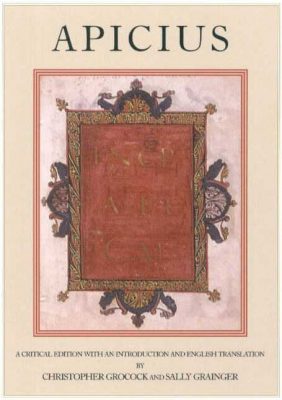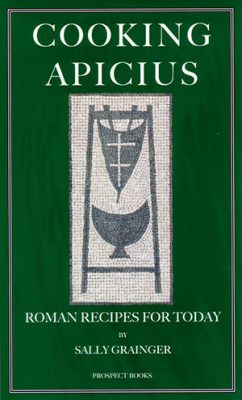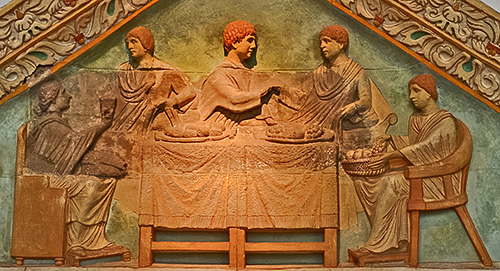
A site dedicated to discovering, through experimental archaeology and textual analysis, how the Romans cooked and consumed their novel cuisine. I am a food historian, ancient cook and archaeologist who over the last 20 years has been working to bring a greater understanding of these issues for scholars, archaeologists and museums.
I am an avowed dinosaur in terms of social media and have until, these crazy Covid times, stubbornly refused to have anything but a basic web presence. Covid gave me time and the need to stay home allowed me to reassess and gave me a growing realisation that the experiences and skills I have are of interest to many and can and should be shared more widely. During the enforced leisure of lockdown, many of us have turned to a simpler way of cooking and experiencing food preparation. The huge interest in sourdough has revealed that many of us want to take our food and its preparation at a slower pace and hopefully reject the obsession with over-processed fast, and, let’s be honest, disappointing modern food. The quicker it is ready the poorer the quality in my view. We all love to barbecue but even at its most sophisticated it is still just cooking meat, fish and vegetables directly over coals. The ancients used a huge array of different types and shapes of ceramic and metal cooking ware that allowed them to be sophisticated cooks. They were able to create complex composite dishes, bake inside small portable ovens and prepare delicate custards and tarts and all in equipment specially designed to allow the heat from either charcoal or embers to be both ‘above’ and ‘below’ the equipment they used. The techniques are largely synonymous with the idea of a Dutch oven. The recipes and other texts can tell us a great deal about these special techniques as we will see but the only way to really comprehend them is through experimentation.
This is still a scholarly approach, where I will show you how ancient food was prepared and cooked using authentic equipment but also how I reached those conclusions using an array of analysis from ancient texts and ethnographic studies. There are still huge gaps in our knowledge and also many differences of opinion as to how certain well-known dishes were prepared. A quick search will reveal numerous sites now discussing these issues. There will always be uncertainty in any study of the intricacies of ancient behaviours culinary or otherwise. Here, the uncertainty and complexity is celebrated: there are no easy answers. If you have a fascination with Roman life and want to know how complex and often how impossible it is to be certain about the nature of the Roman culinary world, this is the place for you.
A brief introduction
For many years now I have been recognised as a foremost – if not the foremost – expert on these practical approaches to Roman food. Museums and universities around the world have called on me over many years when some aspect of their exhibitions and courses require a greater understanding of the cuisine of the Romans. How this actually came about is a long story. I certainly didn’t set out thinking I would become the go-to person on Roman food. It grew out of a recognition that a practical empirical approach could be combined with a scholarly one (utilising Historical Classical and Archaeological sources) and in fact combining these methodologies was essential if some of the more difficult questions were to be solved. It has been a long journey of some 25 years in which research and practical experiments led to a situation where I could effectively say that I understood how many of the ancient recipes worked and how they should taste.
I began my culinary career as a pastry chef, taking up a number of posts in and around London, including the Army and Navy and the Athaeneum clubs. After a while I knew that I had something else I needed to do but I did not know what that was. An interest in I Claudius by Robert Graves and his source Suetonius led me to resume academic study and I took my first degree, in Classical Studies, in my late twenties. I was lucky enough to meet my co-author Andrew Dalby at my first attempt at a Roman banquet and the result was a publishing deal almost before I graduated.
Initially, with my first book, The Classical Cook Book, for British Museum Press, I had no choice but use a modern kitchen to experiment with the ancient recipes, but soon comprehended that much of the style and taste of the food was determined by the equipment and heat source as well as by the use of the rare and unusual ingredients. One could not really understand what was going on in a given recipe without using authentic forms of heat source such as charcoal and wood, and replica Roman cooking pots.
Slowly we (my now husband Dr Chris Grocock, who is a scholar of Latin and Greek and also an excellent carpenter/builder so useful to have around!) acquired good reproductions of the large cooking platforms that could be found in sites such as Pompeii.
We created a portable de-mountable one (such that we used to say we had a flat-pack Roman kitchen and would travel anywhere) and a solid masonry one in our garden for the real experimentation.
We also acquired many dishes, pots, pans made by ceramicists and blacksmiths, who create such items for the increasingly popular historical re-enactment circuit, and we became travelling Roman cooks. Over many years we demonstrated Roman cooking techniques at Roman English Heritage sites across the UK from Hadrian’s wall to Fishbourne. Each weekend in the summer through the millennium years until 2014 we learnt how to give the impression that we were competent Roman cooks and then, as all good cooking skills are learnt by an iterative process, we actually became successful Roman cooks.
Chefs have always learnt by watching and copying, and adjusting their techniques as they learn. In the case of Roman food we are dependant largely on the recipes from Apicius, the collection of recipes attributed to a character called Marcus Gavius Apicius but in reality the text was originally written down by numerous slave cooks for other slave cooks to use and naturally much of the detail we needed to know was missing (because ancient slave cooks had a wealth of shared knowledge which they did not need to repeat). All the information that would make the recipe intelligible to us today had to be discovered from a long process of adapting and experimentation, which ultimately led in 2006 to our edition and translation of Apicius.
Apicius had not been translated into English since the 1950’s and at that time the authors Flower and Rosenbaum were British scholars in a pre Elizabeth David era where Mediterranean cuisine was largely an unknown commodity in Britain. Their Latin was second-to-none but their knowledge of Mediterranean cuisine was very limited. Other edition such as the 1936 edition by Vehling suffered from the reverse problem: considerable culinary knowledge, which sadly led to rather too modern an interpretation, but limited Latin. Uniquely we were able to combine classical scholarship with practical expertise and were able to iron out many of the problems in the text. Along side the rather serious edition – with many scholarly notes and technical linguistic discussion- I was able to put together a modern recipes book of my favourite recipes from Apicius , which we called ‘Cooking Apicius: Roman recipes for today’. Here you will find friendly and accessible recipes that you can reproduce at home. If you are tempted to purchase these books – thankyou if you do- please go to the publisher direct with the link provided, rather than any of the discounting online book retailers. Prospect Books is a small scale enterprise and needs to be supported.
I used to say that I felt I could stand in the sandals of a Roman slave cook and know how he was able to process his dishes. I could also reproduce the flavours of Roman recipes in a way that made the food not only palatable but delicious – sadly this was a major issue as many, in those early days, believed Roman foods was not desirable or pleasant to eat and many struggled to create dishes that were simply good to eat. I remember that back in the early 1990s, those that I met at archaeological and Classical events used to wince when they discussed Roman feasts that they were obliged to consume in the name of friendly scholarship. This negative view is due to a complex mixture of issues: fish sauce was little understood at this time, and the quality of what was available wasn’t that good, the spices were odd and unfamiliar, and as there are few quantities given it is not possible to know precisely how much would have been used. This absence of quantities led some to create unfortunate reconstructions of the recipes and also led to bizarre ideas from some scholars that the Romans created a ‘difficult’ cuisine by any standard of taste, on purpose as a covert strategy to maintain class boundaries (some still do think this!): you were supposed to find Roman food challenging. The recipes are not easy to reconstruct and do require a degree of careful construction as the numerous spices, rich sweet and sour flavours and that notorious fish sauce makes for a unique and unfamiliar taste which can easily be over stated.
Over the years I have maintained my connection to my original career as a chef and acted as consultant and chef in the preparation of many reconstructed ancient feasts at museums and universities around the world. Follow this link to see all the banquets I have organised.
In 2010 I added a MA in Archaeology to my credentials and I found that my fascination with all things fish sauce would serve as my dissertation. Many academic papers have followed in related topics but the study of garum has been my main focus and this has culminated in a new book soon to be published by Routledge called The Story of Garum: Fermented Fish Sauce and Salted Fish in the Ancient World, due out in early spring 2021. Two of my most recent papers on fish sauce can be found on the academia.edu site link and here you can find pages on fish sauce. The nature and qualities of ancient fish sauces in the ancient world are complex and highly contested among archaeologist and historians.
We are nearly up to date in this fast track account of why this site has started. The book on Garum was nearing completion, and in fact the last edits were done at the beginning of lockdown here in the Surrey/Hampshire borders in southern England. Covid has been tragic but also transformative in so many ways. The world will hopefully be renewed and learn from the challenges of trying to function virtually. With this in mind I accepted a commission from a museum in the US to make a film of a Roman cooking demonstration in our own experimental kitchen at home. It had been quite some time since we have demonstrated regularly so I was a little unsure of how this could be achieved. I was also unsure how the filming process would work, as to be honest I have never been comfortable with TV cameras, despite having done quite a lot of TV over the year. Link to TV appearances As it happens the skills came back like riding a bike and I enjoyed the process just as we had done during those years with English Heritage. It was just me and my cameraman Rod Hughes, who happens to be my neighbour and also a skilled craftsman in many of the disciplines required: ceramicist, carpenter and blacksmith to name but three, who has also begun his own film company – Golden Eye Productions. Modern tech these days, such as a super-duper iPhone and a gimbal – whatever that is? – makes the process relatively easy. I found that the iPhone was far less intrusive than a film camera and so much easier to work with. The first films for the client were remarkably successful and so we decided to continue making short films of some of my most successful ancient recipes from Apicius and other ancient texts for ourselves and to share on YouTube. Each film will have an accompanying page on this website with the main references for each dish and an opportunity to comment ask questions and participate in the wider discussion.
I have a vast collection of replica equipment which of cause makes these reconstructions possible. For those who are interested in duplicating these cooking techniques on your barbecue you can find sources for manufacturers of many of the ceramic and metal equipment here. Link to page on replica kit.
Each demo is really a form of experimental archaeology, in which there is no such thing as failure, just an opportunity to learn to do it better and to judge the heat source more precisely. Cooking on charcoal and wood is a special skill that comes with time, patience and repetition.
I hope you enjoy them. If you have questions or comments please add them to the website and if you have your own favourite Roman recipes that you want me to try, I will happily attempt an authentic reconstruction.

